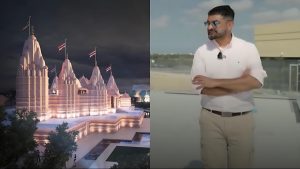2024-01-20 06:25:16
The buzzword today is Ram Mandir, as the grand temple in Ayodhya is all set to be consecrated on January 22. Preparations and rituals have already begun, and Ayodhya has turned into a city that reflects the life of Lord Rama in every corner. Amidst this, there is also a discussion about a Ram temple in Pakistan and the period of Lord Ram’s life there.
A 16th-century temple in the Margalla Hills of Islamabad, known as Ram Mandir or Ram Kund Mandir, holds great significance in Hindu beliefs. But, Hindus are not allowed to worship there, and the idols have been removed. The heritage structure in Sadipur, Pakistan, has now become a tourist attraction, drawing large numbers of people.
Pressed against the foothills of the Himalayas in Islamabad, the tiny sixteenth-century temple is built as a shrine to the Hindu god Lord Ram, who Hindus believe lived in the area with his wife Sita and brother Lakshmana, spending some time during the 14-year exile here.
A pond adjacent to the temple, called ‘Ram Kund,’ further strengthens this belief, as it is said that Rama drank water from it.
The temple is a simple, single-story structure made of red brick. It has a rectangular courtyard with a raised platform in the centre where the idols of Rama, Sita, and Lakshmana were placed.
According to official records dating back to 1893, annual fairs were held at the pond near the site to commemorate the life of Lord Ram. Hindus from far and wide travelled to the temple for worship and stayed in the adjoining dharamshala for centuries.
But since 1947, following the partition, Hindus have not been allowed by Pakistani authorities to worship at the temple and the compound in which it is housed.
When Islamabad city was established in 1960 on the border of the Punjab plains, in the same year, the Rama Mandir Temple complex was converted into a girls’ school. After years of protests by the Hindu community, the school was moved to another location, and the temple was finally vacated in 2006. However, Hindus were still not allowed to worship there.
The shrine today is all but subsumed into a touristy strip of restaurants and handicraft stores. Instead of the freshwater ponds that once surrounded the area and were considered holy by the Hindu community, a contaminated rainwater channel now flows through the village.
A gurdwara was constructed adjacent to the temple by the Sikhs, serving as a school for spreading the teachings of Guru Nanak.
Discussions and movements are ongoing, advocating for the temple’s return to Hindu worship.
Ram mandir, ram temple, ayodhya, Margalla Hills, Sadipur Ram Mandir, Ram Kund Mandir, islamabad, pakistan
Source link
![]()



